The global feed preparation machine market is projected to grow from USD 724.3 million in 2025 to approximately USD 1,011.9 million by 2035, recording an absolute increase of USD 287.6 million over the forecast period. This translates into a total growth of 39.7%, with the market forecast to expand at a compound annual growth rate (CAGR) of 3.4% between 2025 and 2035. The overall market size is expected to grow by 1.4X during the same period, supported by accelerating demand for mechanized feeding systems in livestock operations, breakthrough advancements in feed mixing technology, and expanding adoption of precision agriculture practices across dairy and beef cattle farms.
The steady market expansion reflects the transformative potential of feed preparation technology in revolutionizing livestock nutrition management and agricultural productivity enhancement. Major agricultural equipment manufacturers worldwide are increasingly incorporating advanced feed mixing solutions to enhance operational efficiency and reduce labor costs in feeding operations, while breakthrough developments in automated feeding systems and nutrient mixing precision are creating unprecedented demand for specialized preparation equipment. The livestock sector is experiencing significant growth as dairy farms and beef cattle operations require advanced feed preparation machines that deliver superior mixing uniformity and operational reliability under continuous working conditions.
Manufacturing capabilities are advancing rapidly as leading producers invest in precision engineering facilities and proprietary mixing technologies to meet growing market demand for enhanced mixing performance and reduced maintenance requirements. The technology landscape continues evolving with innovations in auger design, mixing chamber engineering, and control system integration that enhance feed preparation efficiency while reducing power consumption and component wear. Agricultural equipment manufacturers and feeding system specialists are collaborating extensively to develop next-generation feed preparation products that address specific operational requirements across dairy operations, beef cattle facilities, and mixed livestock farming enterprises.
Quality standards are becoming increasingly stringent as applications demand higher mixing precision and greater durability under demanding operational conditions. Industry certification programs and validation protocols ensure consistent product performance while supporting market confidence in feed preparation technology adoption across commercial livestock operations and regulated agricultural environments. Regulatory compliance requirements for feed quality and livestock nutrition are driving investments in comprehensive quality management systems and testing protocols throughout the manufacturing supply chain.
International collaboration is accelerating market development as major livestock operations require coordinated efforts between multiple equipment manufacturers and feeding system suppliers. Global agricultural companies are establishing standardized specifications for feed preparation performance that influence worldwide manufacturing standards and create opportunities for specialized suppliers. Agricultural engineering firms are forming strategic partnerships with equipment manufacturers to develop application-specific solutions tailored to emerging livestock management technologies and operational requirements.
Investment patterns are shifting toward integrated solution development as major end-users seek comprehensive feeding systems that combine feed preparation machines with automated delivery systems and feed management software. Livestock operators are forming joint ventures with technology providers to develop customized feeding platforms, while agricultural equipment manufacturers are acquiring stakes in specialized component suppliers to ensure access to cutting-edge preparation technologies for their equipment programs. This trend toward strategic partnerships and technology integration is reshaping competitive dynamics across the agricultural equipment value chain.
Market maturation is evident in the emergence of specialized application segments that demand unique machine characteristics and performance specifications. Dairy cattle operations require extremely precise mixing capabilities and hygienic design features for milk production quality assurance, while beef cattle systems need robust preparation equipment that handles diverse feed materials and withstands outdoor operating environments. These specialized requirements are driving innovation in mixer materials, drive systems, and control methodologies that extend beyond traditional livestock feeding applications.
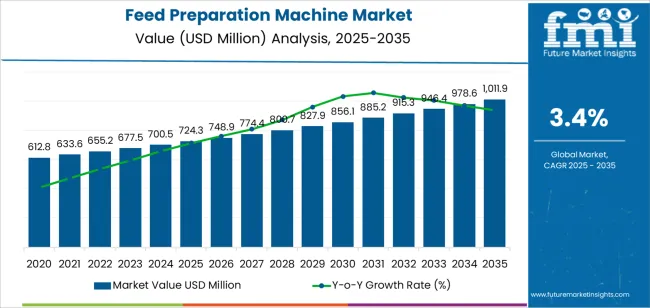
| Metric | Value |
|---|---|
| Market Value (2025) | USD 724.3 million |
| Market Forecast Value (2035) | USD 1,011.9 million |
| Forecast CAGR (2025 to 2035) | 3.4% |
| LIVESTOCK INTENSIFICATION | AGRICULTURAL MECHANIZATION | NUTRITION OPTIMIZATION |
|---|---|---|
| Dairy Industry Expansion - Commercial dairy operations worldwide requiring efficient feed preparation systems for total mixed ration production, supporting milk yield optimization and herd health management with precise nutrient blending and consistent feed quality for large cattle populations under intensive management protocols. | Farm Automation Advancement - Agricultural operations upgrading to mechanized feeding systems and automated preparation equipment requiring precision feed mixing for consistent livestock nutrition delivery, reducing manual labor requirements while enhancing operational efficiency through integrated feeding solutions. | Feed Quality Enhancement - Livestock nutritionists implementing advanced feed preparation techniques for optimal nutrient distribution and digestibility improvement, requiring sophisticated mixing equipment for ingredient homogenization and feed additive incorporation with enhanced precision and consistency characteristics. |
| Beef Cattle Operations - Feedlot facilities and cow-calf operations implementing mechanized feeding programs requiring robust preparation equipment for handling diverse feed materials including hay, silage, grain, and supplements with superior mixing capabilities and operational reliability under continuous use conditions. | Labor Cost Reduction - Agricultural enterprises adopting mechanized preparation systems to address labor shortages and rising wage costs in livestock operations, requiring automated feeding equipment that reduces manual handling while maintaining feed quality and preparation consistency. | Feed Efficiency Improvement - Livestock producers implementing precision feeding programs requiring accurate ingredient mixing and portion control systems for feed conversion optimization, supporting animal performance enhancement while reducing feed waste and operational costs through improved preparation methodologies. |
| Small Farm Modernization - Family-owned livestock operations upgrading traditional feeding methods with mechanical preparation systems requiring cost-effective equipment solutions for improved feeding efficiency, supporting farm profitability enhancement through reduced preparation time and enhanced feed utilization rates. | Technology Integration - Agricultural equipment manufacturers incorporating digital control systems and monitoring capabilities into preparation machines, requiring advanced equipment that supports precision agriculture practices and data-driven feeding management protocols for operational optimization. | Specialty Feed Applications - Livestock operations implementing specialized nutrition programs requiring custom feed preparation equipment for organic farming, grass-fed production, and premium livestock programs with specific mixing requirements and quality standards. |
| Category | Segments / Values |
|---|---|
| By Type | Pull-Type; Stationary; Self-Propelled; Others |
| By Application | Dairy Cattle Farms; Beef Cattle Farms; Mixed Livestock; Specialty Operations; Others |
| By Capacity | Small (under 5 cubic meters); Medium (5-15 cubic meters); Large (15-30 cubic meters); Extra Large (over 30 cubic meters) |
| By End-User | Commercial Dairy Farms; Beef Feedlots; Family Farms; Custom Operators; Others |
| By Mixing System | Vertical Auger; Horizontal Auger; Paddle Mixer; Tumble Mixer; Others |
| By Distribution Channel | Direct Sales; Agricultural Dealers; Equipment Distributors; Online Platforms |
| By Region | North America; Europe; Asia Pacific; Latin America; Middle East & Africa |
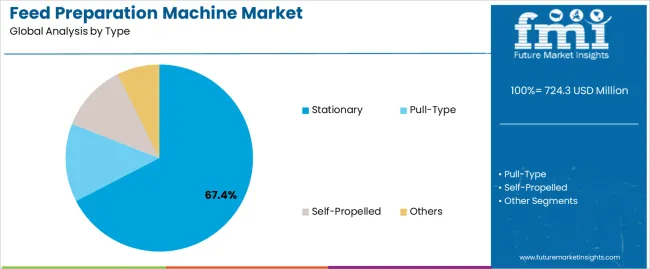
| Segment | 2025 to 2035 Outlook |
|---|---|
| Stationary Type | Leader in 2025 with 67.4% market share; preferred choice for large dairy operations and feedlots requiring high-capacity preparation systems with fixed installation benefits. Widely adopted for commercial facilities needing consistent daily feed preparation volumes. Momentum: steady growth across large-scale livestock operations. Watchouts: limited flexibility compared to mobile systems in diverse operational environments. |
| Pull-Type | Significant segment with 21.8% share, favored for medium-sized operations requiring mobility and versatility across multiple feeding locations. Momentum: strong growth in mixed farming operations and custom feeding services. Watchouts: higher operational complexity compared to stationary systems for single-location applications. |
| Self-Propelled | Specialized segment offering complete mobility and automated operation for large-scale custom feeding operations. Momentum: growing adoption in commercial feeding services and large ranch operations. Watchouts: higher capital investment and maintenance requirements. |
| Others | Includes compact systems and specialized preparation equipment for niche applications. Momentum: selective growth in small farm and specialty livestock applications. |
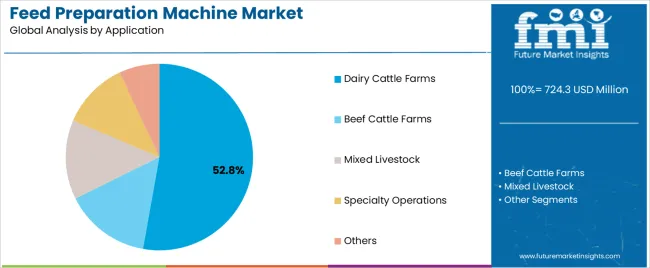
| Segment | 2025 to 2035 Outlook |
|---|---|
| Dairy Cattle Farms | Largest application segment in 2025 at 52.8% share, driven by intensive dairy farming practices and total mixed ration requirements for optimal milk production. Includes commercial dairies and large-scale milk production facilities requiring precise feed preparation. Momentum: robust growth from dairy industry expansion and automation adoption. Watchouts: cost pressure from volatile milk prices affecting capital equipment purchases. |
| Beef Cattle Farms | Critical segment representing 28.4% share, experiencing strong growth from feedlot operations and beef production intensification. Momentum: exceptional growth as beef operations adopt mechanized feeding systems. Watchouts: market volatility and seasonal feeding patterns affecting equipment utilization. |
| Mixed Livestock | Growing segment at 12.7% share for diversified farming operations requiring versatile preparation equipment for multiple animal species. Momentum: steady growth from farm diversification trends. Watchouts: varying nutritional requirements across different livestock species. |
| Others | Includes specialty livestock operations, organic farms, and research facilities. Momentum: diverse growth opportunities across specialized agricultural segments. |
| Distribution Channel | Status & Outlook (2025 to 2035) |
|---|---|
| Direct Sales | Dominant channel in 2025 with 71.3% share for large commercial operations. Provides technical consultation, custom configuration, and comprehensive support for complex preparation systems. Momentum: strong growth driven by large-scale livestock operations requiring direct manufacturer engagement. Watchouts: resource constraints and technical support capacity limitations. |
| Agricultural Dealers | Regional distribution serving local farmers and medium-sized operations with inventory availability and service capabilities. Momentum: moderate growth as market expands beyond core commercial applications. Watchouts: inventory investment requirements and technical training needs. |
| Equipment Distributors | Specialized channel for preparation equipment serving contractors and equipment rental operations. Momentum: growing importance as custom feeding services expand. Watchouts: competitive pricing pressure and service capability requirements. |
| Online Platforms | Emerging channel for equipment components, small systems, and replacement parts serving maintenance facilities and small operators. Momentum: strategic growth as buyers seek convenient procurement and competitive pricing. |
| DRIVERS | RESTRAINTS | KEY TRENDS |
|---|---|---|
| Livestock Industry Growth across dairy and beef cattle operations creating substantial demand for mechanized feed preparation systems supporting increased production volumes, operational efficiency enhancement, and consistent feed quality maintenance for improved animal nutrition and performance optimization. | High Capital Investment and complex financing requirements limit accessibility across smaller farming operations and family-owned livestock enterprises with limited equipment budgets and seasonal cash flow constraints affecting equipment acquisition timelines. | Automation Integration -- Advanced feed preparation machines incorporating automated control systems, recipe management software, and remote monitoring capabilities for precision feeding management and operational optimization through digital technology integration. |
| Labor Cost Increases -- Agricultural operations facing rising labor costs and worker shortages driving adoption of mechanized preparation systems for reduced manual handling requirements, enhanced operational efficiency, and consistent feed preparation quality independent of labor availability fluctuations. | Maintenance Complexity -- Equipment operation requirements, service protocols, and specialized repair procedures affect deployment feasibility for operations lacking dedicated maintenance capabilities and technical expertise for complex machinery management and troubleshooting procedures. | Precision Nutrition Focus -- Implementation of advanced mixing technologies for ingredient uniformity, nutrient distribution optimization, and feed quality consistency supporting livestock performance enhancement and feed conversion efficiency improvement through precise preparation methodologies. |
| Feed Quality Standards -- Regulatory requirements and industry standards for livestock nutrition driving adoption of precision mixing equipment supporting consistent feed preparation, ingredient traceability, and quality assurance protocols for commercial livestock operations and regulated feeding environments. | Equipment Durability Concerns -- Operational wear patterns and component replacement requirements create ongoing maintenance costs and operational disruptions for facilities requiring continuous feed preparation capabilities and consistent equipment availability for daily feeding schedules. | Custom Solution Development -- Manufacturing focus on application-specific equipment design for diverse livestock operations, specialized feeding requirements, and operational constraints requiring tailored preparation systems and integrated feeding solutions for enhanced operational efficiency. |
| Agricultural Modernization -- Farm technology advancement and precision agriculture adoption requiring sophisticated feed preparation equipment supporting data integration, operational monitoring, and performance optimization through advanced control systems and connectivity features. | Training Requirements -- Operational complexity and safety protocols require comprehensive training programs for equipment operators and maintenance personnel, affecting implementation timelines and operational effectiveness for facilities lacking technical expertise and training resources. | Mobile System Innovation -- Development of advanced pull-type and self-propelled preparation equipment offering enhanced mobility, operational flexibility, and multi-location feeding capabilities for diverse agricultural operations and custom feeding services. |
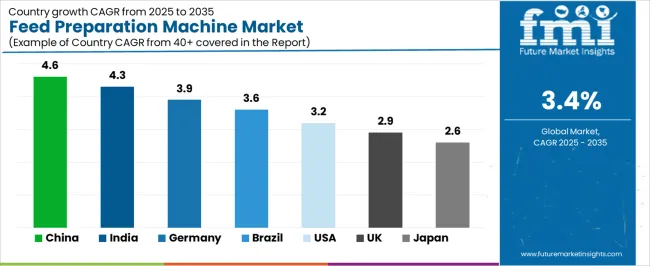
| Country | CAGR (2025 to 2035) |
|---|---|
| China | 4.6% |
| India | 4.3% |
| Germany | 3.9% |
| Brazil | 3.6% |
| United States | 3.2% |
| United Kingdom | 2.9% |
| Japan | 2.6% |
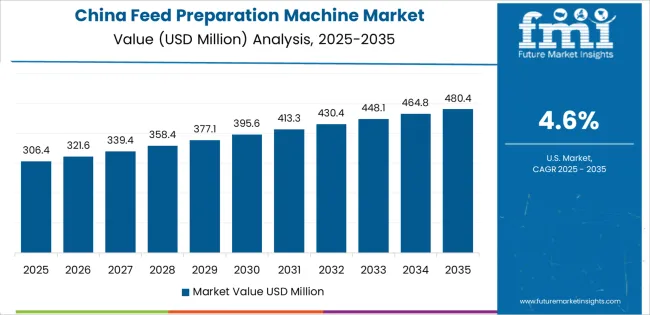
Revenue from Feed Preparation Machine in China is projected to exhibit exceptional growth with a market value of USD 318.7 million by 2035, driven by massive livestock industry expansion and comprehensive agricultural modernization initiatives creating substantial opportunities for feed preparation technology suppliers across dairy operations, beef cattle facilities, and integrated farming systems. The country's ambitious agricultural development programs including national livestock productivity initiatives and mechanization advancement are creating unprecedented demand for efficient feed preparation systems. Major agricultural companies and livestock operations including New Hope Group and modern farming cooperatives are establishing comprehensive feed preparation programs to support large-scale livestock production and operational efficiency enhancement.
Revenue from Feed Preparation Machine in India is expanding to reach USD 287.4 million by 2035, supported by extensive dairy industry development programs and comprehensive livestock improvement initiatives creating demand for feed preparation solutions across diverse farming operations and cooperative dairy systems. The country's growing dairy capabilities and expanding livestock infrastructure are driving demand for preparation equipment that provides exceptional reliability while supporting traditional farming practices and modern dairy requirements. Dairy cooperatives and livestock farmers are investing in preparation technology development to support growing milk demand and agricultural productivity enhancement.
Demand for Feed Preparation Machine in Germany is projected to reach USD 156.8 million by 2035, supported by the country's leadership in agricultural engineering and advanced livestock management systems requiring sophisticated preparation equipment for dairy operations and precision farming applications. German agricultural operations are implementing cutting-edge feeding platforms that support advanced mixing capabilities, operational precision, and comprehensive performance monitoring protocols. The market is characterized by focus on engineering excellence, technology innovation, and compliance with stringent agricultural and environmental standards.
Revenue from Feed Preparation Machine in Brazil is growing to reach USD 142.3 million by 2035, driven by beef cattle industry expansion and increasing agricultural capabilities creating opportunities for preparation equipment suppliers serving both commercial ranches and specialized farming contractors. The country's expanding livestock sector and growing agricultural infrastructure are creating demand for preparation systems that support diverse feeding requirements while maintaining performance standards. Ranchers and agricultural companies are developing technology strategies to support operational efficiency and livestock productivity advancement.
Demand for Feed Preparation Machine in United States is projected to reach USD 201.5 million by 2035, expanding at a CAGR of 3.2%, driven by advanced agricultural technology adoption and specialized livestock operations supporting dairy industry leadership and comprehensive farming applications. The country's established agricultural tradition including major dairy operations and beef cattle facilities are creating demand for high-performance preparation equipment that supports operational advancement and productivity standards. Manufacturers and agricultural equipment suppliers are maintaining comprehensive development capabilities to support diverse farming and livestock requirements.
Revenue from Feed Preparation Machine in United Kingdom is growing to reach USD 187.9 million by 2035, supported by agricultural heritage and established farming communities driving demand for premium preparation solutions across traditional livestock systems and specialized dairy applications. The country's agricultural tradition including major farming operations and established livestock capabilities create demand for preparation equipment that supports both traditional farming advancement and modern agricultural applications.
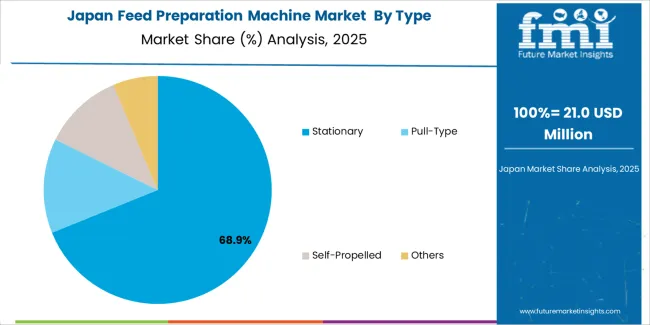
Demand for Feed Preparation Machine in Japan is projected to reach USD 174.2 million by 2035, driven by precision agricultural technology tradition and established farming leadership supporting both domestic livestock markets and export-oriented equipment production. Japanese companies maintain sophisticated preparation equipment development capabilities, with established manufacturers continuing to lead in agricultural technology and farming equipment standards.
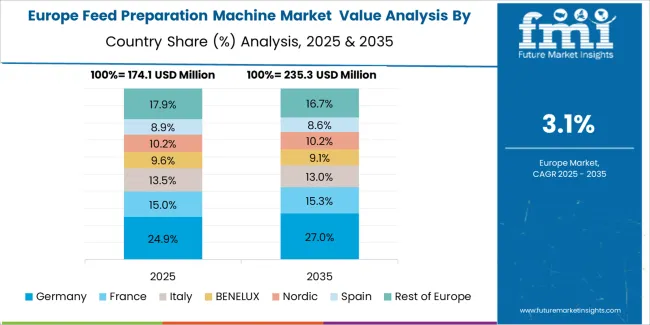
European Feed Preparation Machine operations are increasingly concentrated between German engineering excellence and specialized manufacturing across multiple countries. German facilities dominate high-performance equipment production for dairy operations and precision farming applications, leveraging cutting-edge manufacturing technologies and strict quality protocols that command price premiums in global markets. British agricultural operators maintain leadership in farming innovation and preparation method development, with organizations like agricultural research centers and farming cooperatives driving technical specifications that suppliers must meet to access major agricultural contracts.
Eastern European operations in Poland and Czech Republic are capturing specialized production contracts through precision manufacturing expertise and EU compliance standards, particularly in component fabrication and assembly technologies for agricultural applications. These facilities increasingly serve as development partners for Western European farming programs while building their own agricultural technology expertise.
The regulatory environment presents both opportunities and constraints. European agricultural framework requirements create quality standards that favor established European manufacturers and farming operators while ensuring consistent performance specifications for livestock applications and farming operations. Brexit has created complexity for UK agricultural collaboration with EU programs, driving opportunities for direct relationships between British operators and international preparation equipment suppliers.
Technology collaboration accelerates as farmers seek agricultural advancement to support major productivity milestones and modernization timelines. Vertical integration increases, with major agricultural operators acquiring specialized manufacturing capabilities to secure equipment supplies and quality control for farming programs. Smaller agricultural contractors face pressure to specialize in niche applications or risk displacement by larger, more comprehensive operations serving mainstream farming and livestock requirements.
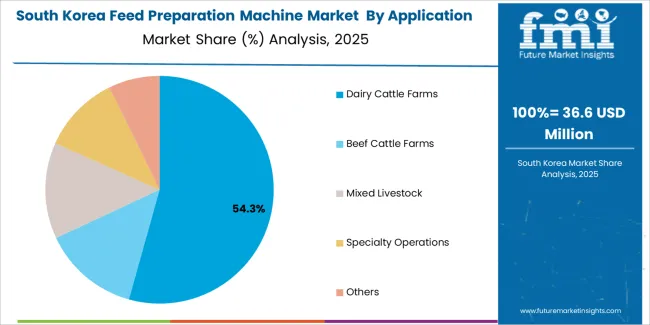
South Korean Feed Preparation Machine operations reflect the country's advanced agricultural modernization capabilities and technology development model. Major agricultural companies and livestock operations drive equipment procurement strategies for their farming facilities, establishing direct relationships with specialized preparation equipment suppliers to secure consistent quality and performance for their livestock programs and agricultural modernization initiatives targeting both domestic food security and export market development.
The Korean market demonstrates particular strength in integrating preparation technologies into precision agriculture platforms and advanced livestock management configurations, with engineering teams developing solutions that bridge traditional farming applications and next-generation agricultural systems. This integration approach creates demand for specific performance specifications that differ from conventional applications, requiring suppliers to adapt preparation capabilities and system coordination characteristics.
Regulatory frameworks emphasize agricultural efficiency and livestock productivity, with Korean agricultural standards often exceeding international requirements for preparation systems. This creates barriers for standard equipment suppliers but benefits established manufacturers who can demonstrate agricultural-grade performance capabilities. The regulatory environment particularly favors suppliers with Korean agricultural qualification and comprehensive testing documentation systems.
Supply chain excellence remains critical given Korea's agricultural focus and food security dynamics. Agricultural operators increasingly pursue development partnerships with suppliers in Japan, Germany, and specialized manufacturers to ensure access to cutting-edge preparation technologies while managing operational risks. Investment in agricultural infrastructure supports performance advancement during extended farming development cycles.
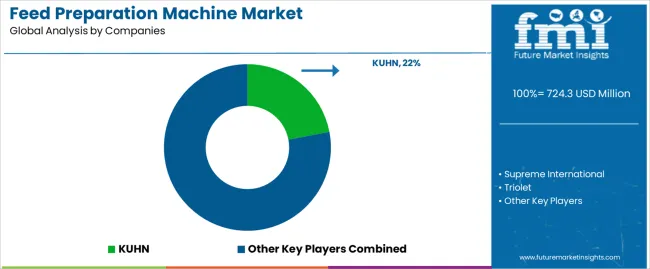
Profit pools are consolidating upstream in advanced equipment manufacturing and downstream in application-specific solutions for dairy operations, beef cattle facilities, and precision farming markets where mixing performance, operational reliability, and exceptional durability capabilities command substantial premiums. Value is migrating from basic equipment production to specification-driven, application-ready preparation systems where engineering expertise, precision manufacturing, and proven performance characteristics create competitive advantages.
Several archetypes define market leadership: established American manufacturers defending share through advanced agricultural technology and comprehensive application support; German precision equipment companies leveraging manufacturing excellence and engineering capabilities; European agricultural leaders with farming expertise and precision manufacturing heritage; and emerging manufacturers pursuing cost-effective production while developing advanced preparation capabilities.
Switching costs - system integration, operational validation, performance qualification - provide stability for established suppliers, while technological advancement requirements and agricultural application growth create opportunities for innovative manufacturers.
Consolidation continues as companies seek manufacturing scale; direct farmer partnerships grow for specialized applications while traditional agricultural distribution remains relationship-driven. Focus areas: secure dairy and beef cattle market positions with application-specific performance specifications and technical collaboration; develop preparation technology and advanced manufacturing capabilities; explore specialized applications including precision agriculture and automated feeding system requirements.
| Stakeholder Type | Primary Advantage | Repeatable Plays |
|---|---|---|
| American Agricultural Leaders | Advanced preparation expertise; proven reliability; established farmer relationships | Precision manufacturing; technical innovation; application support |
| German Engineering Companies | Manufacturing excellence; comprehensive development programs; established customer partnerships | Engineering collaboration focus; integrated solutions; technical consultation |
| European Agricultural Leaders | Farming system expertise; precision technology leadership; trusted by major agricultural programs | Farmer partnerships; application-specific specifications; agricultural collaboration |
| Emerging Technology Producers | Manufacturing efficiency; competitive pricing; rapid technology development | Production scaling; technology advancement; market entry strategies |
| Agricultural Distributors | Technical distribution networks; farmer relationships | Agricultural expertise; inventory management; technical support services |
| Item | Value |
|---|---|
| Quantitative Units | USD 724.3 million |
| Type Segments | Pull-Type; Stationary; Self-Propelled; Others |
| Applications | Dairy Cattle Farms; Beef Cattle Farms; Mixed Livestock; Specialty Operations; Others |
| End-Users | Commercial Dairy Farms; Beef Feedlots; Family Farms; Custom Operators; Others |
| Capacity Segments | Small; Medium; Large; Extra Large |
| Distribution Channels | Direct Sales; Agricultural Dealers; Equipment Distributors; Online Platforms |
| Regions Covered | North America; Latin America; Europe; Asia Pacific; Middle East & Africa |
| Key Countries | China; India; Germany; Brazil; United States; United Kingdom; Japan (+35 additional countries) |
| Key Companies Profiled | KUHN; Supreme International; Triolet; Highline Manufacturing; Groupe Anderson; DuraTech Industries; Jaylor International; Harsh International; Vermeer Corporation; NDEco; Laird Manufacturing; ROTO-MIX; Patz; DYE; Herd-Boss Feeders; Siloking; B. Strautmann & Sohne; Seko Industries; Faresin Industries; Zago Unifeed Division; RMH Lachish Industries; Grupo Tatoma; Storti SpA; Italmix Srl; Keenan; Meyer Manufacturing Corporation; Sgariboldi; Lucas G; Ningxia New Volkswagen Machinery |
| Additional Attributes | Dollar sales by type and application; Regional demand trends (NA, EU, APAC); Competitive landscape; Direct vs. distributor adoption patterns; Agricultural and livestock integration; Advanced preparation innovations driving mixing efficiency enhancement, operational reliability, and feeding precision excellence |
By Type
The global feed preparation machine market is estimated to be valued at USD 724.3 million in 2025.
The market size for the feed preparation machine market is projected to reach USD 1,011.9 million by 2035.
The feed preparation machine market is expected to grow at a 3.4% CAGR between 2025 and 2035.
The key product types in feed preparation machine market are stationary, pull-type, self-propelled and others.
In terms of application, dairy cattle farms segment to command 52.8% share in the feed preparation machine market in 2025.






Full Research Suite comprises of:
Market outlook & trends analysis
Interviews & case studies
Strategic recommendations
Vendor profiles & capabilities analysis
5-year forecasts
8 regions and 60+ country-level data splits
Market segment data splits
12 months of continuous data updates
DELIVERED AS:
PDF EXCEL ONLINE
Feed Additive Nosiheptide Premix Market Size and Share Forecast Outlook 2025 to 2035
Feeder Container Market Size and Share Forecast Outlook 2025 to 2035
Feed Pigment Market Forecast and Outlook 2025 to 2035
Feed Mixer Market Forecast and Outlook 2025 to 2035
Feed Grade Spray-dried Animal Plasma (SDAP) Market Size and Share Forecast Outlook 2025 to 2035
Feed Electrolytes Market Size and Share Forecast Outlook 2025 to 2035
Feed Micronutrients Market Size and Share Forecast Outlook 2025 to 2035
Feed Acidifier Market Analysis Size Share and Forecast Outlook 2025 to 2035
Feed Flavors Market Size and Share Forecast Outlook 2025 to 2035
Feed Enzymes Market Analysis - Size, Share, and Forecast Outlook 2025 to 2035
Feed Mycotoxin Binders Market Size and Share Forecast Outlook 2025 to 2035
Feed Phytogenics Market Size and Share Forecast Outlook 2025 to 2035
Feed Carbohydrase Market Size and Share Forecast Outlook 2025 to 2035
Feed Grade Oils Market Analysis - Size, Share, and Forecast Outlook 2025 to 2035
Feed Packaging Market Size, Share & Forecast 2025 to 2035
Feed Mycotoxin Detoxifiers Market Analysis - Size, Share, and Forecast Outlook 2025 to 2035
Feed Premix Market Analysis - Size, Share, & Forecast Outlook 2025 to 2035
Feed Phytogenic Market Analysis - Size, Share, & Forecast Outlook 2025 to 2035
Feed Attractants Market Analysis by Composition, Functionality, Livestock, Packaging Type and Sales Channel Through 2035
Feed Encapsulation Market Analysis- Size, Growth, and Forecast 2025 to 2035

Thank you!
You will receive an email from our Business Development Manager. Please be sure to check your SPAM/JUNK folder too.
Chat With
MaRIA